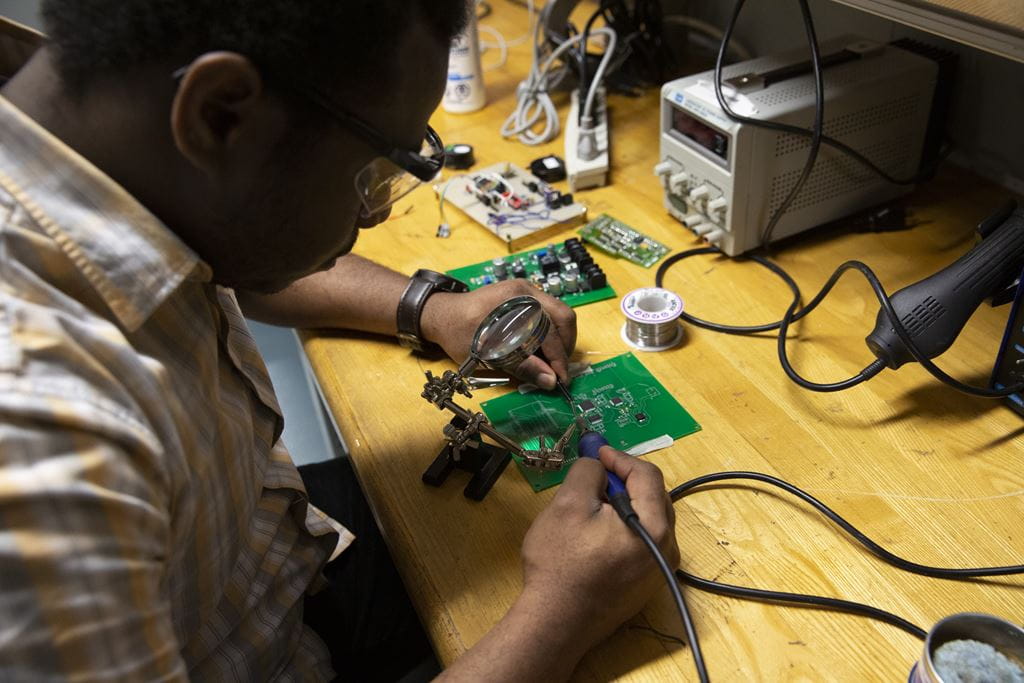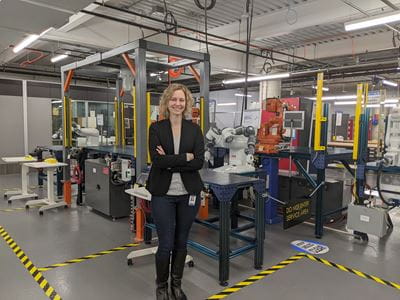
Researcher Spotlight: Dr. Carolyn Moorlag
 by Teresa Baerg – Jan 12, 2022
by Teresa Baerg – Jan 12, 2022 Dr. Carolyn Moorlag is the Director for the Centre for Advanced Manufacturing & Design Technologies (CAMDT) and Director of Faculty of Applied Science and Technology (FAST) Research. Here she discusses some of the challenges faced in the manufacturing industry, how CAMDT projects can benefit both Sheridan and the broader community, and how she sees CAMDT evolving in the coming years.
 What is your professional background and how did your career path and skill set lead you to Sheridan?
What is your professional background and how did your career path and skill set lead you to Sheridan?
Dr. Moorlag: I have a background in conducting industrial research for the printing industry, including in 3D Printing and devices prototyping. I jumped at the opportunity to conduct research in these areas and others at Sheridan’s Centre for Advanced Manufacturing and Design Technologies. My technical background is in both engineering and chemistry, but it is so interesting to engage with all the schools at FAST and expand my knowledge in applied computing, architectural technology, and skilled trades.
I became interested in research at a young age - when I was 18, right after my first year of university. I had the opportunity to collect measurements in a chemical research lab of assembled molecular systems and was so excited when the work was published in a research journal. This early experience made me consider a future in research. After completing a Masters in Metals and Materials Engineering, and a PhD in Materials Chemistry, I started my career as a scientist at the Xerox Research Centre of Canada. During my time in industry, my skill set really changed from being almost entirely technical as an individual contributor, to learning how to work in teams, then how to lead teams and manage people. I also started to develop technology platforms to serve multiple sectors, such as 3D printing for automotive, aerospace and medtech areas. I find it rewarding to impart a broader impact in my work, but I think that you need to start by becoming good at solving specific problems – it’s a progression!
What are some of the challenges CAMDT helps research partners tackle in the manufacturing industry?
Dr. Moorlag: The manufacturing industry requires innovation in processing and the incorporation of new technology to remain competitive and grow into new areas. However, a big challenge is the risk of down-time and disruption to the existing business, as staff are busy ensuring that operations run smoothly. It can be challenging in industry to implement new innovation because of these pressures. We help to mitigate these risks at CAMDT by helping our partners develop and test new technologies, and providing research space, required equipment and expertise to collaborate on projects. At Sheridan, we are fortunate to be able to draw on professor and student expertise from not only the schools of FAST, but also from Sheridan’s other Faculties.
You have an interest in applied research for local businesses, Sheridan and the broader community. Can you give us some examples that show why applied research is more important now than ever?
Dr. Moorlag: Applied research is important because it can be immediately impactful to local businesses. In one recent project, CAMDT was able to develop an automated process for a manual process with a high injury rate. This project incorporated a new design of the process and the implementation of robotics. In many cases, automation is critical to increase workplace safety, and increase manufacturing productivity to grow the business. In other projects, we work with companies to demonstrate technologies as an early-stage prototype. We also possess advanced 3D printing expertise at CAMDT that is used to demonstrate new medical implants. The prototypes allow the business to quickly iterate the design and arrive at the final product configuration in a faster timeframe. This helps local businesses to stay competitive with new, high-impact offerings.
We saw this synergy between research and local partners at work early in the pandemic when there was an urgent requirement for such items as counter shields and face shields. CAMDT quickly established collaborations with local partners in the Brampton area to prepare COVID shields, using machining equipment and expertise available at CAMDT. This project was prioritized over ongoing projects at the time, in order to improve the safety of the local community in the Brampton area. CAMDT projects also enrich Sheridan’s Faculties and students by being applicable to industry, and faculty can hone relevant skills in their areas of expertise. For students conducting research directly on projects, they’re learning to work creatively, solving real world problems with direct exposure to industry and future employers.
CAMDT has experienced significant growth in recent years. How do you see CAMDT growing and evolving in the coming years?
Dr. Moorlag: CAMDT is looking to grow into multiple areas in the coming years. Although still maintaining expertise in advanced manufacturing, adjacent areas which are growing and becoming more important in this sector include industrial cyber-security implementation and incorporating artificial intelligence. In general, applied research is trending towards more multi-disciplinary projects in order to address big challenges. CAMDT is already modelling this approach as we often engage in research collaborations with other Sheridan Research and Incubation Centres and our Sheridan Faculties. A great example is with the animated virtual assistant project.
Sheridan is fortunate to possess expertise in important areas such as virtual reality, artificial intelligence and cybersecurity, and many of CAMDT’s projects could incorporate more of these technologies. Multi-disciplinary research is an important theme, and we should be creative and open to collaborating across potentially very different disciplines when tackling problems.
How do you see yourself inspiring the next generation of innovators?
Dr. Moorlag: I‘ve had the opportunity to meet Sheridan students doing amazing work at CAMDT and in FAST. They are extremely hands-on, not only technically-minded but also creative and innovative in their approach to problem-solving. Although I started in one area of science and technology development in my career, I moved to other areas and to managing a wide variety of projects. I learned early on that by trying something new, especially outside of your comfort zone, you can learn and develop your abilities and confidence substantially. I hope that I can inspire students to take on new opportunities, especially early in their careers.
I really like working with motivated teams – whether it’s my own team at CAMDT and FAST or the companies and community partners who we interact with. I am very proud of the work we’re doing together to make connections with our community and establish trust, so that we can make real progress together.
Background
At work or at home, Dr. Carolyn Moorlag really likes a project. She enjoys the process of building something and getting to the end of it, whether it’s planning a garden space or a kitchen, to feed her love of gardening and cooking, or perhaps acrylic painting or glass blowing. Dr. Moorlag is a strong proponent of work-life balance. “I think that it is important for everyone – men and women – to have that balance in their lives between contributions at work and passions to pursue in the rest of your life,” says Carolyn. For her family, “this time has been a lot of hiking, camping, and board games, but I think that any activity together can be a family experience.”
This interview has been edited for length and clarity.
Media Contact
For media inquiries, contact Sheridan’s Communications and Public Relations team.



